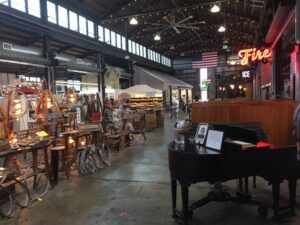WENATCHEE, Wash. — The building pictured with this blog post used to be a warehouse. It contained items to be shipped somewhere else.
Then it was emptied out. It sat vacant for about a year, maybe two … according to what I understand.
Then a wealthy resident of this central Washington community ponied up a couple of million bucks to get started on a repurposing of the former warehouse.
This is what they produced. A sign out front hails it as a “Public Market”; the sign mimics the one along Pike Street in downtown Seattle, the district that features the salmon flung around the “flying fish” market.
They don’t toss salmon at the Wenatchee market, but they do sell a mean cup of mocha, along with sandwiches; they have a deli in there; there’s a brew pub, a Mexican food joint, crafts and assorted other attractions.
They even use the rail line that runs through the building when they want to play host to musical entertainment acts; they wheel the bandstands in on the tracks, clear out the kiosks to create a dance floor and then put it all back together when the evening is over.
The indoor mall that once was a warehouse sits on the Columbia River that winds through this part of the state.
I fell in love with the place.
Communities all over the country are converting warehouses in warehouse districts into places just like this. They also include loft apartments and assorted other uses.
When I see examples of this kind of urban planning, I am filled with hope that our mid-sized and larger cities are not necessarily doomed to rot their way into oblivion.
Sure, it’s nice to have wealthy residents willing to invest in their cities’ future. All cities should be home to someone like that … shouldn’t they?
